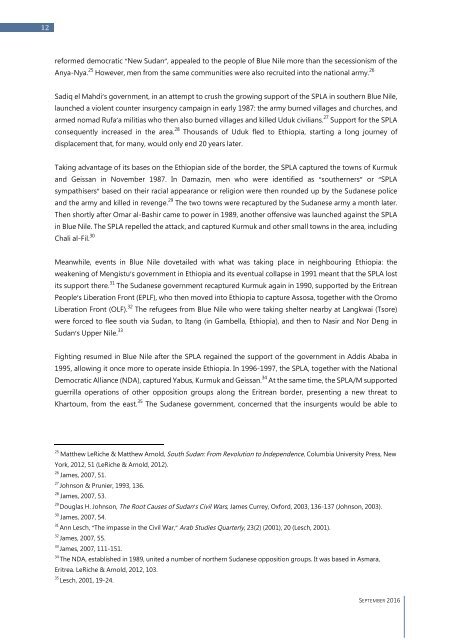A Crisis Normalised
2ctogG9
2ctogG9
You also want an ePaper? Increase the reach of your titles
YUMPU automatically turns print PDFs into web optimized ePapers that Google loves.
12 <br />
<br />
reformed democratic “New Sudan”, appealed to the people of Blue Nile more than the secessionism of the<br />
Anya-Nya. 25 However, men from the same communities were also recruited into the national army. 26<br />
Sadiq el Mahdi’s government, in an attempt to crush the growing support of the SPLA in southern Blue Nile,<br />
launched a violent counter insurgency campaign in early 1987: the army burned villages and churches, and<br />
armed nomad Rufa’a militias who then also burned villages and killed Uduk civilians. 27 Support for the SPLA<br />
consequently increased in the area. 28 Thousands of Uduk fled to Ethiopia, starting a long journey of<br />
displacement that, for many, would only end 20 years later.<br />
Taking advantage of its bases on the Ethiopian side of the border, the SPLA captured the towns of Kurmuk<br />
and Geissan in November 1987. In Damazin, men who were identified as “southerners” or “SPLA<br />
sympathisers” based on their racial appearance or religion were then rounded up by the Sudanese police<br />
and the army and killed in revenge. 29 The two towns were recaptured by the Sudanese army a month later.<br />
Then shortly after Omar al-Bashir came to power in 1989, another offensive was launched against the SPLA<br />
in Blue Nile. The SPLA repelled the attack, and captured Kurmuk and other small towns in the area, including<br />
Chali al-Fil. 30<br />
Meanwhile, events in Blue Nile dovetailed with what was taking place in neighbouring Ethiopia: the<br />
weakening of Mengistu’s government in Ethiopia and its eventual collapse in 1991 meant that the SPLA lost<br />
its support there. 31 The Sudanese government recaptured Kurmuk again in 1990, supported by the Eritrean<br />
People’s Liberation Front (EPLF), who then moved into Ethiopia to capture Assosa, together with the Oromo<br />
Liberation Front (OLF). 32 The refugees from Blue Nile who were taking shelter nearby at Langkwai (Tsore)<br />
were forced to flee south via Sudan, to Itang (in Gambella, Ethiopia), and then to Nasir and Nor Deng in<br />
Sudan’s Upper Nile. 33<br />
Fighting resumed in Blue Nile after the SPLA regained the support of the government in Addis Ababa in<br />
1995, allowing it once more to operate inside Ethiopia. In 1996-1997, the SPLA, together with the National<br />
Democratic Alliance (NDA), captured Yabus, Kurmuk and Geissan. 34 At the same time, the SPLA/M supported<br />
guerrilla operations of other opposition groups along the Eritrean border, presenting a new threat to<br />
Khartoum, from the east. 35 The Sudanese government, concerned that the insurgents would be able to<br />
25<br />
Matthew LeRiche & Matthew Arnold, South Sudan: From Revolution to Independence, Columbia University Press, New<br />
York, 2012, 51 (LeRiche & Arnold, 2012).<br />
26<br />
James, 2007, 51.<br />
27<br />
Johnson & Prunier, 1993, 136.<br />
28<br />
James, 2007, 53.<br />
29<br />
Douglas H. Johnson, The Root Causes of Sudan’s Civil Wars, James Currey, Oxford, 2003, 136-137 (Johnson, 2003).<br />
30<br />
James, 2007, 54.<br />
31<br />
Ann Lesch, “The impasse in the Civil War,” Arab Studies Quarterly, 23(2) (2001), 20 (Lesch, 2001).<br />
32<br />
James, 2007, 55.<br />
33<br />
James, 2007, 111-151.<br />
34<br />
The NDA, established in 1989, united a number of northern Sudanese opposition groups. It was based in Asmara,<br />
Eritrea. LeRiche & Arnold, 2012, 103.<br />
35<br />
Lesch, 2001, 19-24.<br />
SEPTEMBER 2016


